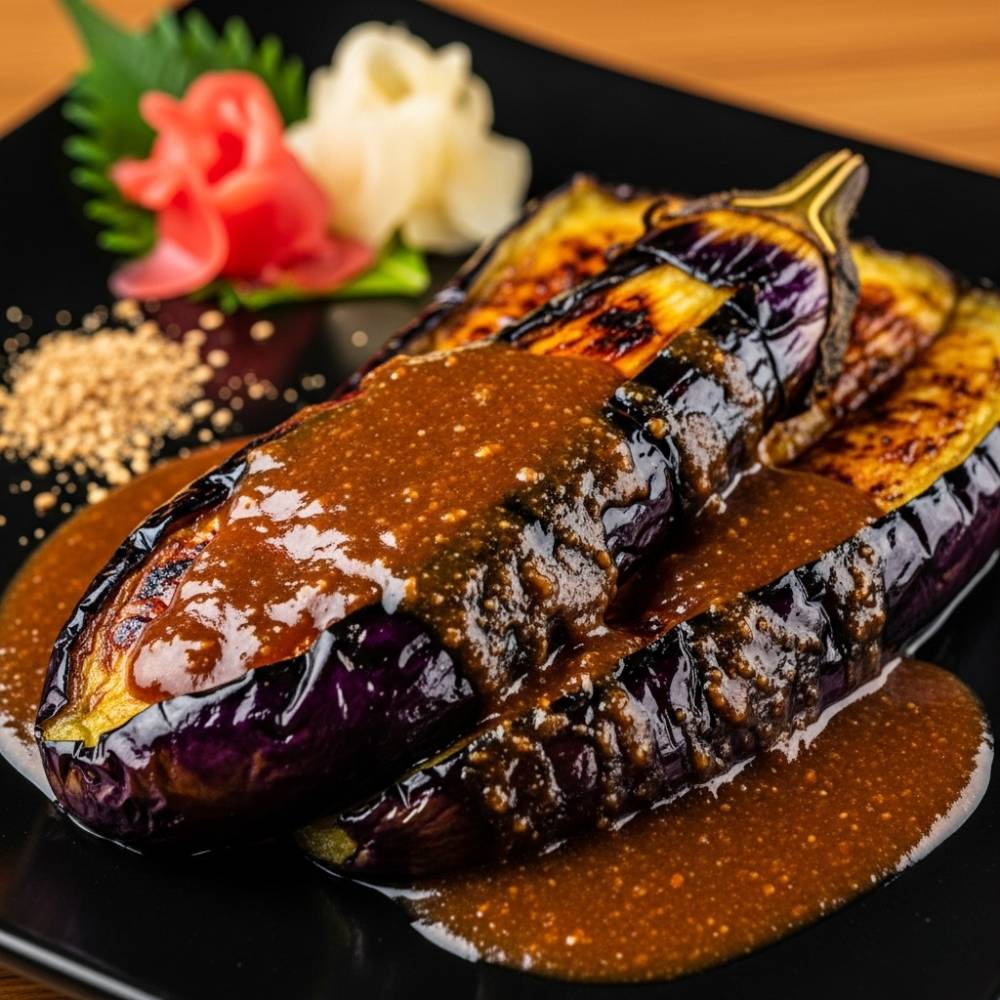Miso Glazed Eggplant (Nasu Dengaku)
Tender eggplant halves brushed with a sweet and savory miso glaze, then baked or broiled until deeply caramelized and soft. A flavorful Japanese side dish or appetizer for two.

Prepare the eggplant
Preheat your oven to 400°F (200°C). Line a baking sheet with parchment paper. Wash the 1 large eggplant and slice it in half lengthwise. Score the cut sides of the eggplant flesh in a crosshatch pattern (cut shallow diagonal lines across it, without cutting through the skin). This helps the eggplant cook evenly and absorb the glaze. Brush the cut sides of the eggplant with 1 tablespoon vegetable oil and sprinkle lightly with 1/4 teaspoon salt. Place the eggplant halves cut-side down on the prepared baking sheet.
💡 Pro Tips:
- •Scoring helps the eggplant cook faster and soak up more flavor.
- •Japanese eggplant is long and thin, while globe eggplant is rounder. Both work.
Bake the eggplant
Bake the eggplant for 15-20 minutes, or until the flesh is softened. This partially cooks the eggplant before glazing. If your eggplant is very thick, it may take a few minutes longer. The eggplant should be tender when pierced with a fork.
💡 Pro Tips:
- •Baking helps to tenderize the eggplant before applying the glaze.
- •Do not overbake at this stage, as it will be cooked again.
Make the miso glaze
While the eggplant bakes, prepare the miso glaze. In a small saucepan or microwave-safe bowl, combine 2 tablespoons white miso paste (a fermented soybean paste), 1 tablespoon mirin (sweet Japanese cooking wine), 1 tablespoon sake (Japanese rice wine) or water, 1 tablespoon granulated sugar, and 1 teaspoon soy sauce (use tamari for gluten-free). Heat over medium-low heat or in the microwave until the sugar dissolves and the mixture is smooth. Simmer (cook gently just below boiling, with small bubbles) for 1-2 minutes until it slightly thickens. Mirin is a sweet Japanese cooking wine. Sake is Japanese rice wine. Simmer means to cook gently just below boiling, with small bubbles.
💡 Pro Tips:
- •Miso paste is a flavorful fermented soybean paste.
- •Whisk well to ensure all ingredients are dissolved.
Glaze and finish eggplant
Remove the partially baked eggplant from the oven. Carefully flip the eggplant halves so the cut-side is facing up. Preheat your oven's broiler (the top heating element). Brush a generous layer of the prepared miso glaze over the cut surface of each eggplant half. Return the eggplant to the oven under the hot broiler for 3-5 minutes, watching very closely, until the glaze is bubbling, slightly caramelized (turned slightly sticky and browned), and lightly charred in spots. Broil means to cook food directly under a high heat source. Caramelized means turned slightly sticky and browned from cooking sugar.
💡 Pro Tips:
- •Watch the eggplant constantly under the broiler, as it can burn quickly.
- •A golden, bubbly glaze is the goal.
Serve
Remove the Miso Glazed Eggplant from the oven. Garnish with 1 teaspoon toasted sesame seeds and 1 tablespoon thinly sliced green onions. Serve immediately as a side dish or light main course.
💡 Pro Tips:
- •Toasted sesame seeds add a nutty flavor and pleasant crunch.
- •Green onions add a fresh, mild onion flavor.
- Baking sheet
- Parchment paper
- Small saucepan or microwave-safe bowl (for glaze)
- Pastry brush
- Measuring cups
- Measuring spoons
- Knife and cutting board
- 💡White miso paste is milder and sweeter, while red miso is saltier and more robust. Choose based on your preference.
- 💡If you do not have sake, dry white wine or just water can be used, though sake adds an authentic touch.
- 💡This dish pairs wonderfully with steamed rice or as part of a larger Japanese meal.
You Might Also Like
Discover more delicious recipes similar to what you're cooking



